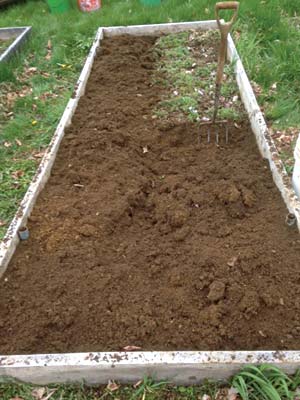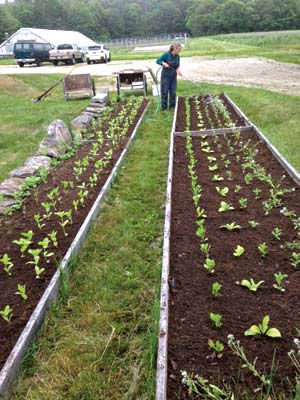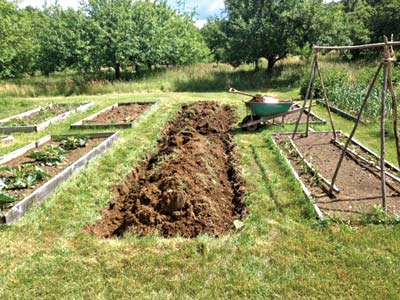 |
| Gardening in beds can save space and soil, and those beds can be raised and framed by boards or other materials, as shown here, or they can be made by moving soil from pathways into the growing area without any frame. Begin bed preparation the summer or fall before planting. |
 |
| Finished raised beds, bordered with lumber and stone and planted in spring. |
By Dave Colson
Photos courtesy of the author
Each spring the MOFGA office receives calls from gardeners looking for “certified organic topsoil” for raised beds in their gardens. We have to respond that certified organic topsoil does not exist.
MOFGA Certification Services certifies the production of crops, livestock and processed products, and verifies that these are produced according to USDA national organic standards. Even though organic production is based on organic soil husbandry, those standards do not involve certifying the soil itself as organic.
We do, however, promote healthy soils. An organic gardener or farmer will spend years building and maintaining soil – a long, slow process that builds soil organic matter and biological health as opposed to the “quick fix” of adding nutrients as synthetic chemical elements that can easily leach, volatilize, or run off during rains or snow melt. As organic stewards we want to protect our soil from such losses; we are not willing to dispose of this capital investment.
How can a gardener accumulate this investment? One way is to grow crops in beds rather than in narrow rows, with beds raised a few inches to a few feet above the surrounding soil or remaining level with the surrounding soil.
English gardener and horticulturist Alan Chadwick brought raised bed vegetable gardening to the United States in the late 1960s when he created gardens at the University of California at Santa Cruz (not the state’s agricultural school). His philosophy and techniques appealed to the “back to the land” movement and were popularized by John Jeavons in his book “How to Grow More Vegetables Than You Ever Thought Possible on Less Land Than You Can Imagine.”
At the time most gardeners were using the tried and true method of raising each vegetable in its own single row with a path on either side. For many crops, creating a larger, 3- to 4-foot-wide growing area (a bed) and reducing the number of paths results in using more of the garden as productive growing space. In addition the growing bed can be accessed from the paths on either side, so the gardener doesn’t need to step on the soil in the bed, thus reducing soil compaction.
Gardening in beds makes sense for saving space and soil, so how do we create one? As with most successful gardening processes, this takes time and planning. To begin with, a raised bed does not necessarily need to be framed by wood or other materials. I have found framed beds to be useful for perennial crops, including culinary herbs such as sage, oregano and thyme, and vegetables such as asparagus, and for some crops needing smaller amounts of space; but for crops such as sweet corn, potatoes and squash, I prefer a more open growing space.
For new gardeners or for those who want to expand their growing space, I recommend working up the area to be used for beds in the summer or fall before that use by hand digging, rototilling or bringing in someone with a tractor-tiller. The process is the same as starting any new garden area, and working the existing grass or other ground cover into the soil helps build organic matter while disrupting competition in the new area. “Cleaning up” the ground for the new garden will take some time and effort, so beginning several months ahead of time is important. An alternative to tilling is to cover the soil with a dark landscape fabric, a tarp or sheets of newspaper covered with mulch to kill the ground cover and allow for easier work the next season.
In the spring of the following season, the tilled or covered area can be worked into beds in a number of ways. Jeavons describes “double digging,” a system of deep soil tillage that involves digging to a depth of two shovel blades and that can quickly jump-start a new garden. The downfall of this system is the amount of work necessary to dig each bed.
An alternative is to lay out the new beds and rake or shovel the soil from the paths onto the bed. This is the process I use each season when I make beds in our hoophouses. At this stage framing the beds isn’t necessary. Adding organic matter with compost will increase the height of the beds even more and create a fluffier soil. For good rooting depth in the beds, I also recommend using a broad fork to loosen the soil deeply without damaging the structure created while developing the bed. You can loosen the soil with a broad fork when forming the beds and then each time the soil is worked for a new cropping season.
 |
| A bed made without a frame by turning soil within the bed area. |
For a framed bed, those who are certified organic are not allowed to use treated lumber because preservatives may leach from it and contaminate the soil. MOFGA recommends that all gardeners avoid treated lumber.
I have used both hemlock and pine boards for beds and find that they last about five years before they need to be replaced. Coating them with boiled linseed oil may add one to two more years, but apply this only to dry wood, since it will not seep into wet wood very well. My current framed-bed garden contains 16 beds, so I replace two to three beds per year.
For those with limited growing area or on rental property, where the longer-term process doesn’t work or where the soil may be contaminated with lead or other toxicants, I recommend covering the ground with an impermeable fabric such as a tarp or other solid plastic sheet, building the bed and filling it with compost. Many garden centers sell compost; check to make sure it came from a reliable source and avoid those made with sewage sludge, which is not allowed in organic production. Contact me if you have questions about a particular compost.
Raised beds, either framed or mounded, can create opportunities for expanded vegetable production on less space than you can imagine. Happy growing!
Dave Colson is MOFGA’s agricultural services director. You can reach him at 207-568-4142 or [email protected].
